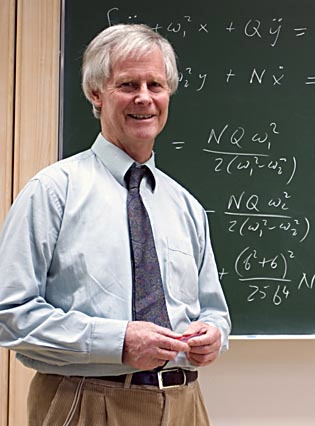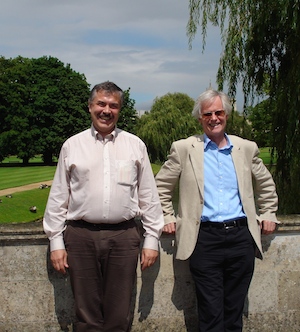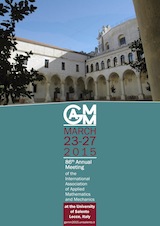 |
Prof. Keith Moffatt University of Cambridge |
Discontinuities and topological jumps in slowly evolving vortical flows
The idea that “vortex lines are frozen” in the flow of an ideal fluid goes back to Helmholtz (1858). However, singular structures such as vortex sheets or filaments are a characteristic feature of such flows, and viscous reconnection of vortex lines can occur in the neighbourhood of such singularities. A model for viscous reconnection suggested by the recent experimental observations of knotted vortex tubes of Kleckner & Irvine (2013) [Nature Phys. 9, 253–258] will be described. A parallel investigation of the response of a soap-film to slow boundary deformation shows that rapid topological jumps can occur here also. The jump of a Möbius-strip soap film from one-sided to two-sided topology provides an intriguing illustration of what is involved in such transitions.
References:
Kimura, Y. & Moffatt, H. K. 2014 Reconnection of skewed vortices. J. Fluid Mech. 751, 329–345.
Goldstein, R. E., McTavish, J., Moffatt, H. K. & Pesci, A. I. 2014 Boundary singularities produced by the motion of soap films. Proc. Natl. Acad. Sci. 111 (23), 8339–8344.
Biography
 Keith Moffatt is Emeritus Professor of Mathematical Physics and Fellow of Trinity College, Cambridge. His speciality is Fluid Dynamics, with many contributions in magnetohydrodynamics, turbulence, and low-Reynolds-number flow. Born and schooled in Edinburgh, Scotland, he graduated in mathematical sciences from Edinburgh University in 1957, and took his PhD in Cambridge under George Batchelor in 1962. He is well known for the discovery of corner eddies in Stokes flow in 1964, and for the discovery of helicity as a topological invariant of the Euler equations in 1969. His monograph “Generation of Magnetic Fields in Electrically Conducting Fluids” (CUP 1978) is the standard introduction to dynamo theory, with applications in geophysics and astrophysics. He edited the Journal of Fluid Mechanics for 18 years (1966-1983).
Keith Moffatt is Emeritus Professor of Mathematical Physics and Fellow of Trinity College, Cambridge. His speciality is Fluid Dynamics, with many contributions in magnetohydrodynamics, turbulence, and low-Reynolds-number flow. Born and schooled in Edinburgh, Scotland, he graduated in mathematical sciences from Edinburgh University in 1957, and took his PhD in Cambridge under George Batchelor in 1962. He is well known for the discovery of corner eddies in Stokes flow in 1964, and for the discovery of helicity as a topological invariant of the Euler equations in 1969. His monograph “Generation of Magnetic Fields in Electrically Conducting Fluids” (CUP 1978) is the standard introduction to dynamo theory, with applications in geophysics and astrophysics. He edited the Journal of Fluid Mechanics for 18 years (1966-1983).
Keith Moffatt has spent most of his career in Cambridge, with a three-year break as Professor of Applied Mathematics at Bristol University (1977-1980). He served as Head of DAMTP in Cambridge (1983-1991), as Director of the Isaac Newton Institute (1996-2001) and as President of the International Union of Theoretical and Applied Mechanics (IUTAM) (2000-2004). He was elected FRS in 1986, and is a member of the National Scientific Academies of France, Italy, the Netherlands, and USA (National Academy of Sciences). He holds honorary doctorates from Grenoble, Edinburgh, Glasgow, Eindhoven, and the State University of New York (SUNY at Utica). He has won many awards including the Panetti-Ferrari International Prize and Gold Medal, the Hughes Medal of the Royal Society, the Senior Whitehead Prize (London Mathematical Society), the European Fluid Mechanics Prize, and the David Crighton Medal.



